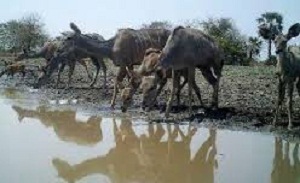Mozambique park sees wildlife numbers grow after war

Lions are getting pregnant and the waterbuck population is soaring at one of Mozambique’s main national parks, once the scene of fighting during a civil war which virtually wiped out the park’s lions, elephants and many other species.
The 15-year conflict that killed up to 1 million people ended in 1992, and some former battlefield foes are now working together as rangers at Gorongosa National Park, where foreign donors and conservationists helped launch a turnaround on a continent accustomed to bad news about wildlife welfare.
Still, the park remains vulnerable to poachers and other problems. Tourism dropped in 2013 and 2014 during sporadic violence linked to the rivalry between Renamo, Mozambique’s main opposition group, and its former adversary during the civil war, the ruling Frelimo party. The park is also in Sofala province, an opposition stronghold in central Mozambique.
Gorongosa became a national park under Portuguese colonizers in 1960. The decade that followed is considered the park’s heyday; actors John Wayne and Gregory Peck and author James Michener went on safari there, according to the park’s website.
The civil war began in 1977 after Portugal’s exit from Mozambique. Fighters killed Gorongosa’s elephants for their ivory and slaughtered other animals, emptying a once-teeming landscape. Widespread poaching continued after a peace deal.
Today, there is a lot to see, thanks largely to a 2008 deal in which a non-profit group founded by American philanthropist Greg Carr pledged at least $1.2 million annually to the restoration of Gorongosa for 20 years. More funding came from European governments, the United States Agency for International Development and other donors.
Workers have built tourism facilities, planted trees and relocated buffalos, hippos and elephants from neighboring South Africa into Gorongosa; money has flowed to poor local communities whose support for the park is seen as indispensable.
“Things are really starting to go quite fast,” said Marc Stalmans, director of scientific services at Gorongosa, which encompasses 1,570 square miles (4,070 square kilometers) and was expanded to include the mountain of the same name in 2010.
The numbers tell a remarkable story of recovery, particularly at a time when populations of threatened species are under pressure from poachers and human encroachment elsewhere in Mozambique and in much of the rest of Africa. Even so, the counts in Gorongosa are generally far below what they were before the war.
The estimated elephant population went from 2,500 in the early 1970s, to fewer than 200 in 2000, and more than 500 in 2014. Similarly, researchers have counted nearly 60 lions, double the number a few years ago, but below the estimated 200 in 1972.
Four lions were pregnant in December, and at least one of them has produced a litter, Stalmans wrote in an email to Associated Press.
“The biggest cause of mortality is lions becoming ‘by-catch’ in snares and traps set for antelopes by the poachers,” Stalmans said. “A significant percentage of our lions have lost toes or part of a paw to snares and traps but managed to break loose. Some unfortunately die.”
The waterbuck population is more than 34,000, 10 times the figure recorded 40 years ago. It is likely the single largest group of waterbuck in Africa, according to park managers.
Jen Guyton, an ecologist working in Gorongosa, believes one reason that waterbucks have bred so fast is because, unlike other antelope, they like eating weeds that replaced grasses on floodplains, a change in vegetation possibly related to the massive loss of wildlife during the war. Experts have noted significant changes in the ecosystem, apparently linked to the animal slaughter, and are trying to understand them.
Another theory is that waterbuck survived the civil war in greater numbers than other species, and are simply growing in population at what is considered a normal rate.
Most of the park is inaccessible by road. To keep track of wildlife, researchers have installed 50 motion-sensitive cameras, amassing several hundred thousand images. Some cameras can only be reached by helicopter, including in limestone gorges. Some cameras were destroyed by elephants or inundated by rising rivers and were replaced.
Under Gorongosa’s “WildCam” project, online volunteers help sort the vast amount of data, logging onto an interactive website and identifying animals in photos, noting how many are visible and reporting what they are doing (“resting” and “eating” are options).
The wildlife resurgence has led to new challenges, including conflict between villagers and elephants encroaching on farmland. Also, the goal of a park reliant on its own revenue is distant — it reported just 2,300 tourists in 2015, far below visitor numbers in major parks in, for example, South Africa and Kenya.
Gorongosa’s last rhinos, a species under heavy threat today, were wiped out in the 1970s. One day, park managers hope, rhinos will again roam there.
News Source: Times of India

